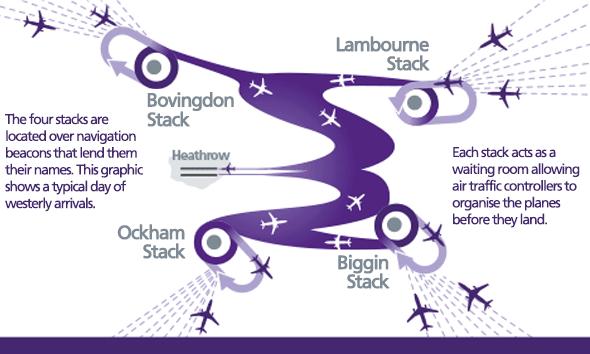
Heathrow is one of the busiest two-runway airports in the world with about 1,300 combined take-offs and landings a day. Efforts to limit noise mean that fewer people are affected by noise today than at any time since the 1970s. However, noise remains an issue for people living near or under the various flight paths used for take-offs and landings at the airport.
On average there are around 650 arrivals into Heathrow each day. Planes start arriving into Heathrow from 4:30am.
Because Heathrow is so busy, aircraft coming in to land at Heathrow are frequently held in holding stacks. Aircraft usually come into a holding stack where they fly in an oval pattern to wait for a landing slot. From the holding stack they follow a set of instructions issued by air traffic controllers (ATC). These instructions direct the aircraft towards the final approach. Aircraft circle at different levels within the stacks until there is space for them to land into Heathrow. The levels are separated by 1,000ft, and the lowest level (i.e. the bottom of the stack) is around 7,000ft.
There are four holding stacks at Heathrow, known as ‘Bovingdon’, ‘Lambourne’, ‘Ockham’ and ‘Biggin’. The locations of the stacks have been the same since the 1960s.
Aircraft enter the stack, circle and descend. When they leave the stack they are directed by ATC onto the final approach to land at Heathrow. The controllers manage the order of the aircraft from all four stacks and guide them safely onto one of Heathrow’s two runways.
There are no set routes for planes moving from the holding stacks to the final approach. While the overall patterns have remained similar for many years, the position of aircraft in the skies varies from flight to flight and day to day.
Factors such as how busy the stack is, weather conditions, or the position of other aircraft on route into Heathrow will impact how aircraft are sequenced by air traffic controllers to leave the stack and make their way to the final approach.
An arrivals procedure known as a ‘Continuous Descent Approach’ has been in operation at Heathrow for many years. Once aircraft have been directed out of the holding stack, CDA involves maintaining a steady angle of approach until they reach the final approach. The intention of CDA is to reduce arrival noise by keeping aircraft higher for longer. In addition, CDA reduces fuel burn and emissions, which leads to an overall environmental benefit. We report the percentage of arrivals that perform CDA on our monthly Operations Dashboards.
An aircraft is on its final approach when it is lined up with the runway to land. The final approaches into Heathrow’s runways extend about 13 nautical miles (15 miles) from the end of each of the airport’s two runways. The point at which aircraft join the final approach varies on a flight by flight basis depending on how aircraft need to be sequenced by the controllers.
Aircraft landing at Heathrow follow a radio beam known as the Instrument Landing System (ILS) to align directly with the runway. The ILS is a precision runway approach aid employing two radio beams to provide pilots with vertical and horizontal guidance during the final approach to landing. Pilots use it to guide them to the runway and the 3 degree approach angle.
Each runway has its own beam which is aligned with its centreline to ensure aircraft approach in a straight line as they come into land. These approach flight paths are fixed.
Once aircraft reach the final approach they cannot lose too much altitude as they need to be at a certain height when they join the final approach into Heathrow. The angle of landing for the final approach is set at 3° and as a result aircraft will be at a set height for distance from the runway. A small percentage of aircraft fly a slightly steeper 3.2° approach, causing them to fly higher for longer. (Find out more here).
The Airport’s AIP (Aeronautical Information Publication) states that the minimum height at which aircraft can join the ILS during the day (between 6am and 11pm) is 2,500ft which is approximately 7.5 nautical miles (around 8.5 miles) from Heathrow. At night (between 11pm and 6am) an aircraft must be no lower than 3,000ft which is approximately 10 nautical miles (around 11.5 miles) from Heathrow.
Aircraft can join the final approach at any point after the distances mentioned above. However, this will vary depending on how aircraft are sequenced each day by the controllers.
The majority of flights finish at Heathrow by 11:30pm, however sometimes late arrivals are unavoidable for a number of reasons. We are working with the airlines and NATS to reduce the number of flights that operate later than scheduled as we know they are disruptive to local residents.
An arriving aircraft might land late into Heathrow because the flight has been delayed leaving the airport it is arriving from, or because of bad weather on route to Heathrow.
Weather conditions such as severe thunderstorms or heavy snowfall can cause widespread disruption to our flight schedule and cause significant delays. In specific circumstances where prolonged and widespread delays occur on the airfield and terminals become congested to unacceptable levels, government guidance allows flights during the night period to be ‘dispensed’. These are in exceptional circumstances such as emergencies or situations where serious hardship or suffering to passengers would result.
Find out more about the Arrivals Code of Practice

